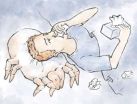(Press-News.org) Freezing and thawing might not be good for the average steak, but it seems to help wood frogs each fall as they prepare to survive Alaska's winter cold.
"Alaska wood frogs spend more time freezing and thawing outside than a steak does in your freezer and the frog comes back to life in the spring in better shape than the steak," said Don Larson, University of Alaska Fairbanks graduate student and lead author on a recent paper demonstrating that freeze tolerance in Alaska wood frogs is more extreme than previously thought.
Although wood frogs are well-studied freeze-tolerant amphibians, Larson's research is believed to be the first to examine the frogs under natural conditions.
In subarctic Interior Alaska, wood frogs overwinter in the ground covered by duff and leaf litter, creating a hibernacula, where temperatures can remain below freezing for more than six months with minimum temperatures of minus four (minus 20 Celsius).
Tracking wood frogs to their natural hibernacula, and using a fenced hibernacula in the Biological Reserve north of the UAF campus, Larson and co-author Brian Barnes, director of the UAF Institute of Arctic Biology and an expert in cold-climate physiology, wanted to know how cold and how long Alaska's wood frogs could survive in their natural habitat.
"Imagine what happens when you suck on a freeze pop," said Larson. "After you've sucked out all the sweet stuff, you're left with just ice. That's what happens to cells when they freeze. As ice formation pulls the water out of cells, the cells desiccate or dry out and eventually die."
Frogs prevent this freeze-pop effect by packing their cells with glucose (a kind of sugar) that reduces drying and stabilizes cells, a process scientists call cryoprotection.
"Concentrating sugar inside the cell helps balance the concentration of salts outside the cell that occurs as ice forms," said Barnes. "Less water leaves the cell than if sugar was not present and sugar and other cryoprotectants are thought to "hold" water inside the cell."
The curious thing Larson discovered is that when wood frogs are outside in their natural environment they accumulate much higher concentrations of glucose in their tissues than do frogs frozen in the lab.
Glucose concentrations in the outside frogs were 13-fold higher in muscle tissue, 10-fold higher in heart tissue and 3.3-fold higher in liver tissue compared to lab-frozen frogs, as described in their paper published in the Journal of Experimental Biology.
This extra protection enabled frogs to survive colder temperatures for a longer time than scientists previously thought, but Larson and Barnes wondered how they accumulated so much glucose?
Larson thinks the process that creates freezer burn on a frozen steak gives frogs the ability to survive being frozen at minimum temperatures below zero (minus 18 Celsius) for up to 218 days with 100 percent survival.
Frogs collected from sites in the Eastern U.S. and Canada have previously been shown to only survive being frozen for a few weeks and to no lower than about 19 degrees (minus 7.2 Celsius).
"In the field in early Autumn it's freezing during the night, thawing slightly during the day, and these repeated freezing episodes stimulate the frogs to release more and more glucose," Larson said. "It's not warm enough for long enough for the frog to reclaim much of that glucose and over time it accumulates giving the frog more protection against cell damage."
Lab-frozen frogs are held at a constant temperature and without the freeze-thaw cycles Larson observed in the wild and so the frogs made glucose only when they initially froze and that was that.
"Whether the extremes in freezing tolerance in Alaska frogs as compared to more southern populations are due to patterns of temperature change during freezing or are due to genetic differences, and thereby represent evolutionary change, awaits further study," said Barnes.
The feats of freezing frogs are more than just a curiosity and may one day have application in the science of human organ transplantation.
"If science can figure out how to freeze human organs without damage it would allow more time to reach people in need of organs," said Larson.
INFORMATION:
This research was funded by the National Science Foundation.
ADDITIONAL CONTACTS: Don Larson, djlarson@alaska.edu, 907-474-6067. Brian M. Barnes, bmbarnes@alaska.edu, 907-474-7649.
VIDEO: http://bit.ly/IAB-WoodFrog
Alaska frogs reach record lows in extreme temperature survival
2014-07-22
ELSE PRESS RELEASES FROM THIS DATE:
Study examines presence of uterine cancers at the time of hysterectomy using morcellation
2014-07-22
Among women undergoing a minimally invasive hysterectomy using electric power morcellation, uterine cancers were present in 27 per 10,000 women at the time of the procedure, according to a study published by JAMA. There has been concern that this procedure, in which the uterus is fragmented into smaller pieces, may result in the spread of undetected malignancies.
Despite the commercial availability of electric power morcellators for 2 decades, accurate estimates of the prevalence of malignancy at the time of electric power morcellation (in this study referred to as morcellation) ...
The 92 percent clean plate club
2014-07-22
If you're a member of the Clean Plate Club – you eat pretty much everything you put on your plate – you're not alone! A new Cornell University study shows that the average adult eats 92% of whatever he or she puts on his or her plate. "If you put it on your plate, it's going into your stomach," says Brian Wansink Ph.D., author of the forthcoming book, Slim by Design, Professor of Marketing and Director of the Cornell Food and Brand Lab.
Wansink and co-author Katherine Abowd Johnson analyzed 1179 diners and concluded that we're a Clean Plate Planet. Although diners ...
Essays in English yield information about other languages
2014-07-22
Computer scientists at MIT and Israel's Technion have discovered an unexpected source of information about the world's languages: the habits of native speakers of those languages when writing in English.
The work could enable computers chewing through relatively accessible documents to approximate data that might take trained linguists months in the field to collect. But that data could in turn lead to better computational tools.
"These [linguistic] features that our system is learning are of course, on one hand, of nice theoretical interest for linguists," says Boris ...
NASA's Fermi finds a 'Transformer' pulsar
2014-07-22
VIDEO:
Zoom into an artist's rendering of AY Sextantis, a binary star system whose pulsar switched from radio emissions to high-energy gamma rays in 2013. This transition likely means the pulsar's...
Click here for more information.
In late June 2013, an exceptional binary containing a rapidly spinning neutron star underwent a dramatic change in behavior never before observed. The pulsar's radio beacon vanished, while at the same time the system brightened fivefold in gamma rays, ...
Forty-five percent rise in diagnostic imaging tests by GPs -- new study
2014-07-22
A 45 per cent rise in diagnostic imaging tests ordered by Australian GPs is being driven by increasing GP visits, a rising number of problems managed at consultations and a higher likelihood that GPs order imaging tests for these problems, according to a new University of Sydney study released today.
Based on a long term national survey of 9,802 GPs between 2002 and 2012, the report draws on data from more than 980,000 GP-patient encounter records to assess the extent to which GP's order tests in line with diagnostic imaging guidelines.
"Most imaging tests ordered by ...
Gene variant identified as a heart disease risk factor for women
2014-07-22
When it comes to heart disease, Dr. Ross Feldman says women are often in the dark. Historically, it was thought that heart disease was a men's-only disease, however, data has shown that post-menopausal women are just as likely as men to get heart disease and are less likely to be adequately diagnosed and treated. New research from Western University published online this week in the British Journal of Clinical Pharmacology brings to light a genetic basis for heart disease in women and helps to identify which women are more prone to heart disease.
The study, led by Dr. ...
Researchers create vaccine for dust-mite allergies
2014-07-22
If you're allergic to dust mites (and chances are you are), help may be on the way.
Researchers at the University of Iowa have developed a vaccine that can combat dust-mite allergies by naturally switching the body's immune response. In animal tests, the nano-sized vaccine package lowered lung inflammation by 83 percent despite repeated exposure to the allergens, according to the paper, published in the AAPS (American Association of Pharmaceutical Scientists) Journal. One big reason why it works, the researchers contend, is because the vaccine package contains a booster ...
Activity level may predict orthopedic outcomes
2014-07-22
According to a literature review in the July issue of the Journal of the American Academy of Orthopaedic Surgeons (JAAOS), patients' activity level is a strong predictor for how well they will do with certain treatments and how well they recover from injuries after treatment. Patients are encouraged to ask their orthopaedic surgeon if activity level is an important factor in their treatment decision. For example, more active patients are at a higher risk of re-injury after an anterior cruciate ligament (ACL) reconstruction, and activity level should be considered when deciding ...
UI study finds potential genetic link between epilepsy and neurodegenerative disorders
2014-07-22
A recent scientific discovery showed that mutations in prickle genes cause epilepsy, which in humans is a brain disorder characterized by repeated seizures over time. However, the mechanism responsible for generating prickle-associated seizures was unknown.
A new University of Iowa study, published online July 14 in the Proceedings of the National Academy of Sciences, reveals a novel pathway in the pathophysiology of epilepsy. UI researchers have identified the basic cellular mechanism that goes awry in prickle mutant flies, leading to the epilepsy-like seizures.
"This ...
Death of a parent during childhood is associated with greater mortality in early adulthood
2014-07-22
Experiencing the loss of a parent during childhood or adolescence is associated with a greater risk of mortality, according to a study published in this week's PLOS Medicine. The study, conducted by Jiong Li and colleagues from Aarhus University in Denmark, finds that individuals who lost either a mother or a father during childhood had a greater risk of mortality in the years following the parent's death compared with people unaffected by parental death during childhood.
The researchers reached these conclusions combining data from national registries from all children ...



